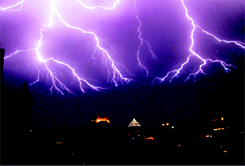 |  |
Did you know?
Flooding affects over 80% of waterfront municipalities and costs an average of $10 million to $15 million annually. Floods, which occur most frequently in the southern part of the province, are the most common type of natural catastrophe in Quebec.
 July 1996 Catastrophic flooding in the Saguenay (François Morneau, Transports Québec) |
 January 1998 Half the population of Quebec is left without power in the wake of an ice storm (Hydro-Québec) |
These are only two examples of extreme weather, but every region of Quebec is vulnerable to such events.
The projected climate change could result in an increased number of violent summer events because a warmer, wetter climate is conducive to the development of severe thunderstorms. Moreover, regions that have thus far escaped relatively unscathed could also be affected. The potential consequences are numerous, for both inhabited areas (e.g. more frequent flash floods) and natural ecosystems, where forest fires caused by lightning could become more frequent occurrences.
 Montréal thunderstorm (Robin Tremblay) |
Did you know?
In summer, the parts of Quebec most affected by violent weather phenomena are the regions of Montréal and Montérégie, where over 20 events - violent winds, torrential rains and flooding, and hail - are reported each year.
| 2006-10-06 |